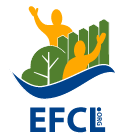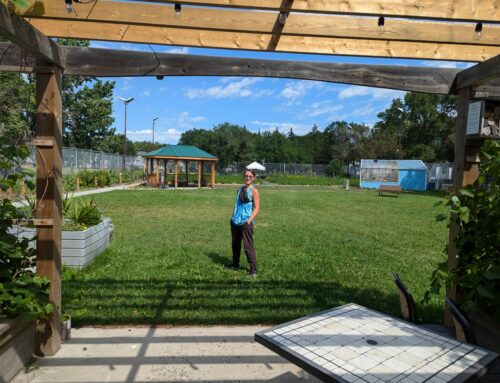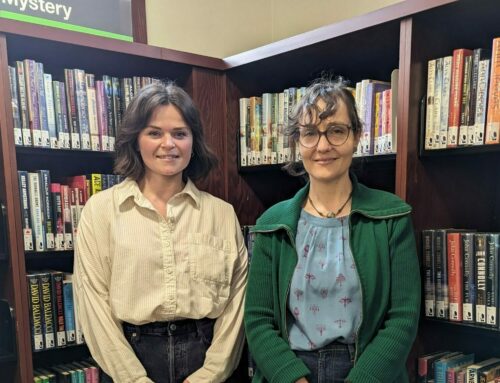Images courtesy of Shannon Clarke, Kyla Roth and Christina Hamer.
A park isn’t really a park until people make it one. So, when the Beverly Heights Community League set out to deal with a disused playground tucked behind the No Frills at 118 Avenue between 34 Street and 36 Street, they knew that it wasn’t changes to the space that were the real key: it was showing people what could happen when they came to gather in the heart of their community.
“If you looked at what the park looks like today compared with what it looked like before, it’s been a dramatic change,” says civics director Chris Keeler, who was one of the driving forces behind revitalizing the pocket park. “We’ve really seen the community come together around the park. There’s this sense now that it’s our park — we belong here.”
To be sure, there have been physical changes to the space, too: most notably a beautiful, bright mural by Christina Hamer, pictured above, that transformed gray walls into something as colourful as the neighbourhood that surrounds the park. But even that was driven by the people who know fill the park: before painting was even discussed, it was up to community activators Shannon Clarke and Kyla Roth to raise the neighbours, canvassing door to door to find out what people wanted, needed and even considered possible for the park.

Shannon Clarke, left, and Kyla Roth.
Paid for by a Community Safety and Well-being Grant, they were armed with free League memberships, a few questionnaires and a mandate to program the park. Their ability to go out and directly connect with people was essential, says Keeler: “Without them, this project would not have been what it’s become. It wouldn’t have been successful.”
Both Clarke and Roth bring some expertise in fostering community from their day jobs: Clarke as a community librarian and Roth as the Senior Supportive Housing Manager at Leston Holdings. It was the fact some of Roth’s buildings sit on the edges of the park that first got her involved, as Clarke and Keeler were specifically looking for a way to get the residents, who traditionally hadn’t been much involved in the Community League, connected and active.
“The people we were really trying to reach are the people who lived close enough to walk,” notes Clarke. “We really found that the best way to get someone out was to give them something very low stakes. We started by asking them what they wanted to see at the park, and then we just gave them a reason to get out to the park.”
The activities ranged from Teepee teachings around National Indigenous Peoples Day to impromptu potlucks inspired by neighbours who wanted to share their cooking to a parade that circled through the community. They also featured plenty of opportunities for kiddos, from something as organized as an art class provided by a local teacher to something as chaotic as pulling over a hose from one of the apartment buildings and letting the kids blast each other with water.
“So many of the things that the League offers are so organized: you need to know about it in advance, maybe sign up in advance — this was just stop by if you want, take part if you want, stay as long as you want”
The key, says Roth, wasn’t so much what was happening, but that something was happening, consistently, so eventually everyone knew that if they came by on the designated Thursday, there would be a chance to connect.

The Teepee ceremony at the Beverly Pocket Park
“So many of the things that the League offers are so organized: you need to know about it in advance, maybe sign up in advance — this was just stop by if you want, take part if you want, stay as long as you want,” Roth explains. “We were always a bit worried if anyone would come, but especially once people realized it was happening all the time — I don’t think we once ever had enough stuff for everyone. But everyone still had fun.”
For Clarke, the benefits of the low-key but regular meet-up was evidenced by someone like Rosie, an older neighbour who lived near the park and told them, during one of their door-knocking sessions, that she was eager for something to do, but didn’t know where to start.
“She talked about how, in the old country, people got together every weekend, there was always some event happening in the community, and she just didn’t see that happening,” Clarke says. “When she found out all she had to do was show up at the park on Thursdays — she was there every time. Sometimes all she did was sit and watch the children, but all she wanted was that chance to be around other people. And she actually ended up running into someone she used to ride the city bus with every day on her way to work, and they’ve reconnected.”
What’s good for the people living next to it has been good for the park — and for the League, too.
“We’ve had a chance to get them into the League —they get all the mailouts, we see them at the free swim down at the ACT Centre, and they’ve started getting into the fold, taking part in more,” says Keeler. “It’s gone from that general park activation to one on one connections with all kinds of people we maybe didn’t know before.”
Though the grant has since rolled up, everyone involved is hopeful that the good times will keep rolling: the mural isn’t going anywhere, and neither are the monthly meet-ups.
“We’ve really seen that, when a small group starts to care about a space, everyone else starts to treat that differently, too,” notes Clarke. “We hope this will all just keep going.”

The community parade brought the spirit of the park to the streets





